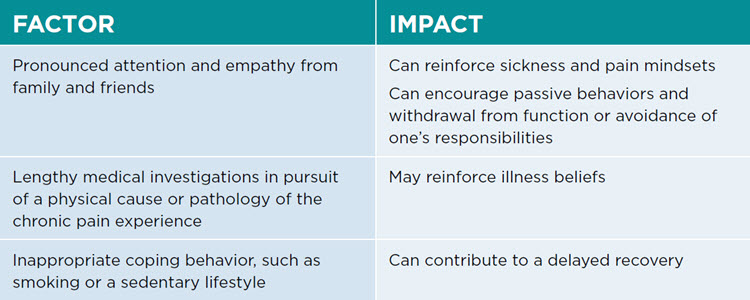Each year, millions of American workers develop health problems that have the potential to temporarily or permanently prevent them from working.
In the large majority of these cases, employees can either stay at work (SAW) in spite of the condition or return to work (RTW) after a brief recovery period.
For some, a work-related injury or illness can cause significant work absence and life disruption. This can sometimes lead to a longer or even permanent withdrawal from work.
What Happens If an Employee Gets Hurt or Sick from Their Job?
If an employee gets hurt or sick from their job and can’t work, they’re considered “disabled.” Many of these workers become involved with one or more programs addressing disability benefits or lost time. This can include:
- Sick leave
- Workers’ compensation insurance (WC insurance)
- Short-term disability (STD)
- Long-term disability (LTD)
- Social Security Disability Income (SSDI)
- Leaves under the Family Medical Leave Act (FMLA)
- Other state-specific medical leave programs
Many people who end up receiving disability benefits have conditions that began as common everyday problems, like sprains or strains or other conditions, like anxiety or depression.
What Keeps Employees From Recovering and Returning to Work?
Ever wonder why an employee isn’t getting better or why they have a delay in their recovery? Since there can be several variables impacting an injured employee’s health, it’s important that we understand the factors that may be preventing or postponing their return to work.
Faulty Diagnosis Can Delay an Employee’s Return to Work
A missed or wrong diagnosis can delay recovery because the injured or sick worker won’t get the right treatment.
According to the National Academy of Sciences, clues to an incorrect or missed diagnosis include:
- Recovery is taking longer than you’d expect based on management guidelines
- The condition or symptoms are getting worse
- Additional diagnosis testing gets ordered, like imaging, lab work, electrodiagnostic tests
- Treatment durations and types are growing
- Medication doses are increasing, or additional medications get prescribed
How a Quality Network Can Help Improve Diagnostic Accuracy
The Hartford developed a number of programs to help ensure employees get properly diagnosed and receive appropriate treatment. One of these programs involves our Medical Provider Network to help care for injured or sick employees. Our past experience shows that medical and indemnity results are better with network care since we review and select medical providers based on clinical outcomes.
Network doctors are experienced in treating workplace injuries and facilitating an injured employee’s return to work. In California, we’ve implemented The Hartford Select NetworkSM (HSN). It not only focuses on taking advantage of cost discounts, but it increasingly focuses on the quality of providers within the network. HSN is unique and highly customized.
Psychosocial Factors and Mental Health Conditions Impacting Return to Work
Certain psychosocial and psychological issues can have an impact on an employee’s recovery. For example, depression or anxiety combined with social challenges like loneliness or the fear of reinjury can delay a worker’s recovery. The key factors that contribute to delayed recovery include:
- Fear
- Passivity
- Catastrophic thinking
- Perceived injustice
- Lack of coping skills

Without the right interventions and support systems in place, these employees can spend more time out of work. When it comes to psychosocial factors and mental health conditions, it’s imperative the injured or sick worker has a personalized, team approach to treatment.

How iRECOVER® Can Help Employees Return to Work
Sometimes, an employee’s diagnosis may be correct, but recovery delays can happen for many reasons. We developed an innovative program called iRECOVER® to help injured workers recover and return to work as soon as possible. The program uses advanced data analytics and predictive modeling to help improve recovery and claim outcomes.
Our data analytics team developed the Claimant Outlier Model (COM) tool. It allows us to:
- Text mine for various risk factors, including psychosocial yellow flags and comorbid conditions.
- Identify individuals at risk for developing chronic pain and disability.
With iRECOVER, The Hartford:
- Identifies injured workers at higher risk for prolonged recovery
- Invites them to work with a specific health coach (participation is voluntary)
- Sends an initial toolkit to those who accept, which includes a workbook, pedometer and audio materials
- Addresses aspects of recovery through personalized coaching
Our proprietary program employs a coach, workbook and tools to teach and develop the skills necessary to:
- Address emotional reactions
- Positively influence behavior
- Improve a person’s ability to recover from an illness or injury

Early Intervention Leads to Improved Outcomes, Faster Return to Work
Medical literature and research confirm that early biopsychosocial interventions that are designed to reduce behavioral risk factors lead to improved claim outcomes. And they’re key to successful return-to-work programs.
iRECOVER is an intervention program designed to help disabled claimants overcome barriers to return to work. It also helps them become active participants in their recovery so they can safely return to their active and productive lives.
An Employer’s Role in Stay-At-Work and Return-To-Work Programs
Outside of biopsychosocial factors, another barrier to an employee’s recovery and return to work is administrative roadblocks. Employer’s play an essential role when it comes to return to work. They have to:
- Assist the injured worker in accessing adequate health care
- Provide the opportunity to return to work at full duty as soon as possible
- Consider offering alternative work or modified duty if a complete return to full duty isn’t possible
An effective stay-at-work or return-to-work (SAW/RTW) program allows an employer to:
- Assess whether, when and how a worker returns to work during or after recovery
- Aim to keep an employee working at an appropriate level, despite a medical condition
Importance of Supervisor Responsiveness With Return to Work
It’s important for supervisors to be responsive during the return-to-work process. In fact, workers with disabling conditions indicate that a major determinant in whether they return to work is the responsiveness of their supervisor. They can do this by:
- Modifying work
- Facilitating access to a company and medical resources
- Monitoring the worker’s recovery
- Communicating a positive message of concern and support
- Maintaining communication with the employee
- Being ready to accommodate and support the employee through their recovery
Alternative Work Can Improve Outcomes
Alternative work can benefit both employer and employee. It can reduce the number of lost workdays through:
- Minimizing the undue focus on a complete return to full duty – without restrictions
- Considering acceptable options for a gradual and/or partial return to work with some accommodation

Assessing an Injured Worker’s Ability to Work
The SAW/RTW program evaluation process begins when a medical condition or other precipitating event occurs. The employee’s current ability to work is assessed on three important dimensions:
- Functional capacity: What can they do today?
- Functional impairments or limitations: What can’t they do today that they could do before?
- Medically based restrictions: What should they not do because it may cause medical harm?
The demands of the worker’s usual job and temporary alternative tasks available should be compared with the worker’s current functional capacity, limitations and medical restrictions. The employer should identify the practical actions necessary to bridge any gaps in returning the employee to work and should consider alternative work activities.
How Employers Can Create an Effective Stay-at-Work or Return-to-Work Program
Effective and successful SAW/RTW programs create and promote a healthy workplace. Employers can use these tips to create or review their own programs:
Use your SAW/RTW program to improve injured worker outcomes and minimize lost productivity. This type of program is defined by any process that minimizes disability from occupational injuries and illnesses. Program components include planning, training and accommodation.
Actively attempt to return an injured employee to work at the earliest opportunity, provided the treating physician has approved the proposed work arrangement.
Work with all available resources to develop partnerships that facilitate SAW/RTW programs. You may want to include stakeholders such as:
- Your workers’ compensation insurance (WC insurance) company case manager who coordinates contact with health care providers, employees and managers/supervisors.
- A safety management representative that can work with supervisors to modify tasks or worksites and arrange alternative work assignments.
- Employees, supervisors and human resources professionals who must be continuously educated about the SAW/RTW process and its benefits.
- Treating physicians who have experience in disability prevention and management, and understand their role in the SAW/RTW process.
Learn more about iRECOVER and other unique WC insurance services and programs designed to get hurt or sick employees back to work faster.
The information provided in these materials is intended to be general and advisory in nature. It shall not be considered legal advice. The Hartford does not warrant that the implementation of any view or recommendation contained herein will: (i) result in the elimination of any unsafe conditions at your business locations or with respect to your business operations; or (ii) be an appropriate legal or business practice. The Hartford assumes no responsibility for the control or correction of hazards or legal compliance with respect to your business practices, and the views and recommendations contained herein shall not constitute our undertaking, on your behalf or for the benefit of others, to determine or warrant that your business premises, locations or operations are safe or healthful, or are in compliance with any law, rule or regulation. Readers seeking to resolve specific safety, legal or business issues or concerns related to the information provided in these materials should consult their safety consultant, attorney or business advisors. All information and representations herein are as of February 2022.
Links from this site to an external site, unaffiliated with The Hartford, may be provided for users' convenience only. The Hartford does not control or review these sites nor does the provision of any link imply an endorsement or association of such non-Hartford sites. The Hartford is not responsible for and makes no representation or warranty regarding the contents, completeness or accuracy or security of any materials on such sites. If you decide to access such non-Hartford sites, you do so at your own risk.
The Hartford Financial Services Group, Inc., (NYSE: HIG) operates through its subsidiaries, including the underwriting company Hartford Fire insurance Company, under the brand name, The Hartford,® and is headquartered in Hartford, CT. For additional details, please read The Hartford’s legal notice at https://www.thehartford.com.






